
by

Khao San Road. 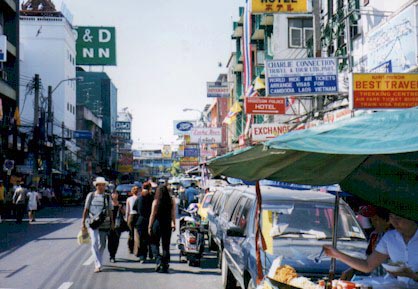 This is Bangkok's legendary backpacker haven. Budget travellers flood into the street, appearing in all shapes, sizes and ages, and coming from all over the planet, favouring all manner of cuisines and practising every religion known to humankind. Every manner of dress, hairstyle and body ornament is on parade. Conformity is definitely not in vogue. Some of these visitors are fashionably chic; others look like they have just crawled out of the gutter. Most of them, however, are just normal folks dressed in casual clothes.
This is Bangkok's legendary backpacker haven. Budget travellers flood into the street, appearing in all shapes, sizes and ages, and coming from all over the planet, favouring all manner of cuisines and practising every religion known to humankind. Every manner of dress, hairstyle and body ornament is on parade. Conformity is definitely not in vogue. Some of these visitors are fashionably chic; others look like they have just crawled out of the gutter. Most of them, however, are just normal folks dressed in casual clothes.
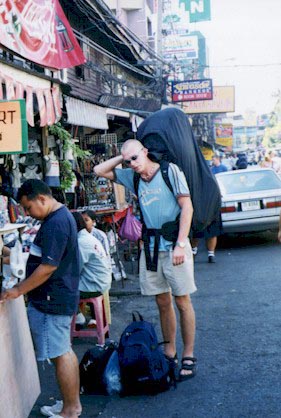 In the early 1970s, the backpacker route across Asia featured stopovers in Kabul, Kathmandu and Vientiane. Accessibility to the latter became extremely difficult in 1975, after the Communists took over, and the 1980 Russian invasion of Afghanistan pretty much put the kibosh on backpacking through that country. Over time, then, the major backpacker route in Asia evolved into the 3Ks: Nepal's Kathmandu, Bangkok's Khao San Road, and Bali's Kuta Beach.
In the early 1970s, the backpacker route across Asia featured stopovers in Kabul, Kathmandu and Vientiane. Accessibility to the latter became extremely difficult in 1975, after the Communists took over, and the 1980 Russian invasion of Afghanistan pretty much put the kibosh on backpacking through that country. Over time, then, the major backpacker route in Asia evolved into the 3Ks: Nepal's Kathmandu, Bangkok's Khao San Road, and Bali's Kuta Beach.
In Thailand, the first guesthouse catering to backpackers in the late '60s was the Thai Soon Greet Guest House, near the Hualampong railway station. Over time, as more and more backpackers came to Thailand, they started to set up shop in and around the Malaysian Hotel, on Soi Ngam Duphli. Then, in the early '80s, they started to shift to Khao San, today's backpacker central.
The Thai government's decision to celebrate Bangkok's 200th anniversary, in 1982, by launching a number of events around the Grand Palace to generate more tourism revenue did much to encourage this shift. The backpackers arrived in numbers, and finding a scarcity of affordable accommodation, began convincing local residents on and around Khao San to rent out vacant rooms in their homes. These short-term stays generated an unexpected steady stream of income, and soon budget guesthouses, shops and restaurants catering to backpackers were popping up everywhere in the area. Word travelled fast, and Khao San soon became the destination of choice for backpackers passing through Bangkok.
Those early hard-core backpackers would cringe today, knowing that McDonald's and Burger King have impinged on their sacred turf. But times change, and Khao San really started to evolve after the regional economic crisis hit in '97. Business people in the area realized they needed a greater range of clients, so they started building more upscale restaurants, guesthouses and cafés — Khao San now even has a boutique hotel. This coincided with a refurbishment of nearby Phra Athit Road, where today the Tourism Authority of Thailand (TAT) stages many shows, including a catwalk fashion show featuring international and well-known local models.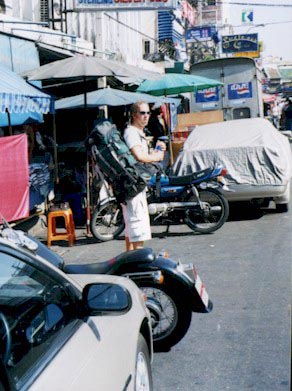
TAT Governor Juthamas Siriwan herself realizes that, while backpackers might not spend as much as more affluent tourists at one sitting, they tend to stay for longer and spread their money among people who would not usually see tourist revenue on the mainstream travel route.
Just about anything is on sale on KSR. Whether it be postcards, film, clothing, jewellery, second-hand books or magazines, medicine, food, videos, tapes, airline tickets or elephant trips around Chiang Mai, you can buy it on Khao San Road.
Many feel the street is lost somewhere in time, probably back in the '60s. The tie-dyed clothing and fashions that many of the young people wear seem a throwback to Woodstock. But it's really a latter-day Haight-Ashbury.
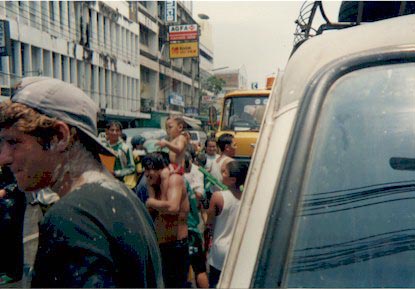 On any given day, at least 50 different nations are represented on the street. Lining up to queue at one currency exchange was a French woman, an Israeli, an Irishman, a Canadian, a German woman, a Norwegian, a Malaysian, a Japanese woman, a Peruvian and a woman from Zimbabwe — all dressed in a myriad of fashions and colours. “The United Hippie Nations,” as one bystander remarked.
On any given day, at least 50 different nations are represented on the street. Lining up to queue at one currency exchange was a French woman, an Israeli, an Irishman, a Canadian, a German woman, a Norwegian, a Malaysian, a Japanese woman, a Peruvian and a woman from Zimbabwe — all dressed in a myriad of fashions and colours. “The United Hippie Nations,” as one bystander remarked.
Every restaurant or guesthouse seems to have a VCR. People park themselves out front to catch up on the films they've missed while travelling. These places make good spots for people to exchange information about places they've just visited or places they plan to go.
During Songkran (the mid-April traditional Thai New Year), Khao San is one big waterfight. The Bangkok Post and The Nation carry front-page photos of Thais and foreigners dousing each other with buckets of water and water guns. It's impossible to stay dry on Khao San during this event.
Beyond being a fascinating place to visit, Khao San makes a good place to stay, if you're on a budget.
The road is a little Nepalese, a little Israeli, a little Nigerian, a little American, a little British and a little French, but most of all it's Thai. A Freak Street to some, a bargain paradise to others, the prevailing attitude towards this multicultural way station is mai pen lai .
Editor's note: Khao San itself means “husked rice”, since in years gone by the area and its labyrinth of canals was a major thoroughfare for rice traders.
Backpacking
Backpackers, unfortunately, have a terrible reputation. Many people think that they are all dirty, pot-smoking, heroin-smuggling skinflints who only stay in the cheapest form of accommodation to help support their on-going drug habits. But most backpackers are actually students or young professionals and others who just want to see the world.
Most don't work while they travel, so they have to stretch their savings as far as they can. Many stay in cheap dives or eat very basic food so they can keep on truckin'. Many forego even the simplest pleasures so they can pay for their next bus ticket. Indeed, some of them become so key-nieow , so stingy, they don't even get a chance to enjoy some of the things they have travelled halfway around the world to see. Some must wonder why they even bothered leaving home.
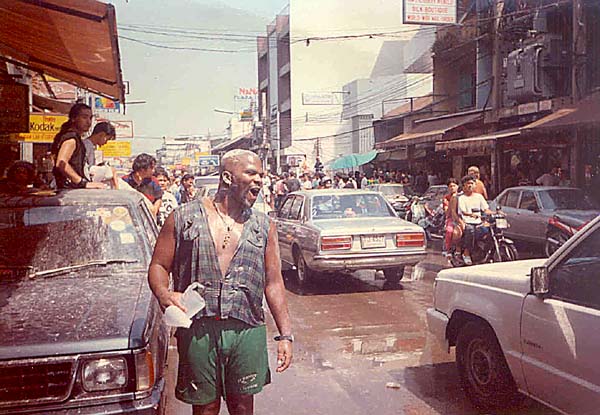 Backpacking can be a tough life. Third class all the way, is the usual mode of transport. Hard seats, cramped accommodation, scummy toilets, having to watch every baht … Doesn't sound like much fun, does it? So why do they do it? The backpacker's guru, Tony Wheeler, may be part of the answer. Through his informative and well-written Lonely Planet series, Wheeler and his wife Maureen have glamourized the life of the backpacker, inspiring many others to hit the road.
Backpacking can be a tough life. Third class all the way, is the usual mode of transport. Hard seats, cramped accommodation, scummy toilets, having to watch every baht … Doesn't sound like much fun, does it? So why do they do it? The backpacker's guru, Tony Wheeler, may be part of the answer. Through his informative and well-written Lonely Planet series, Wheeler and his wife Maureen have glamourized the life of the backpacker, inspiring many others to hit the road.
Backpackers say that they get a chance to see the country as it really is, without any illusions or falsehoods. They get a chance to meet “real” people, eat real food and stay in real places. When they leave, they bring away a feeling they have truly experienced the country.
Hard-core backpackers see themselves as travellers, rather than “backpackers”, and they frown on those who look down on them, accusing them in turn of not experiencing life to the max and not “seeing a country as it really should be seen”. They despise the label “tourist”, and you most certainly will catch a hairy eyeball for trying to apply it to them.
Some backpackers are changed dramatically by their journeys. They see so much poverty and suffering in their travels that, when they return home to their developed nations, they want to do something to help the poor and under-privileged.
FINIS